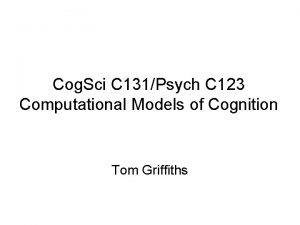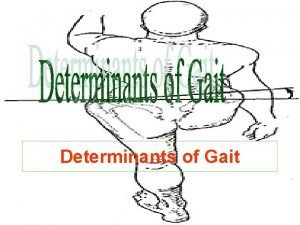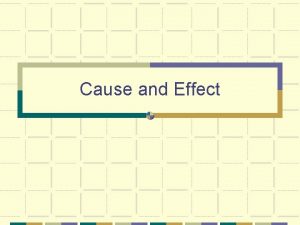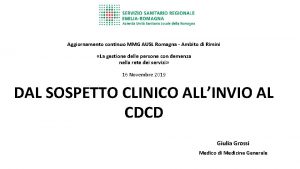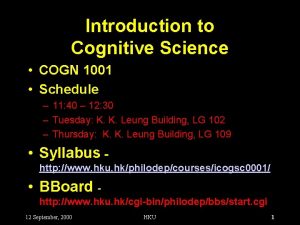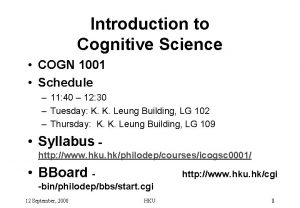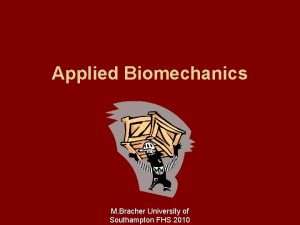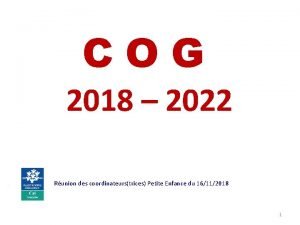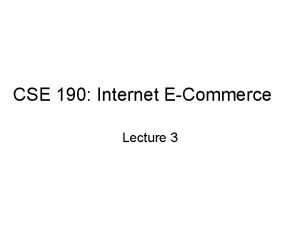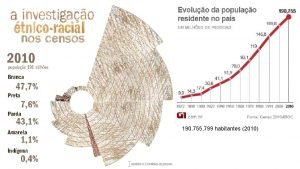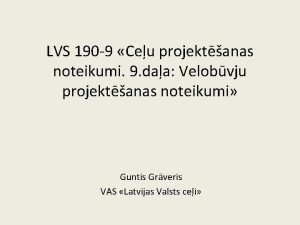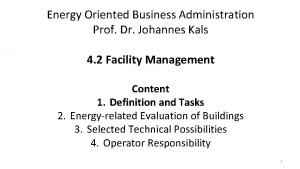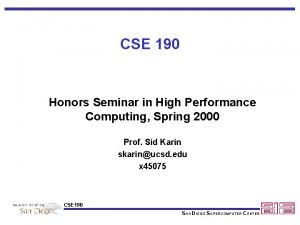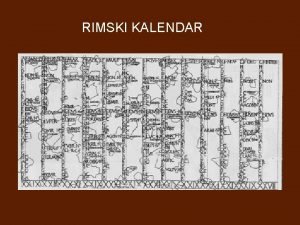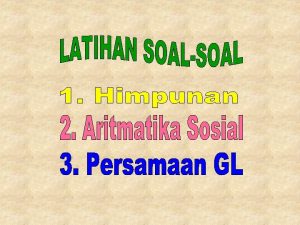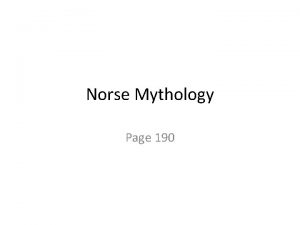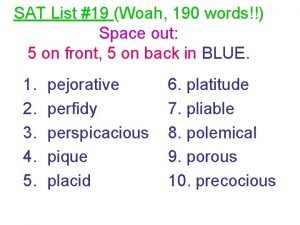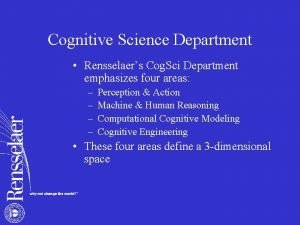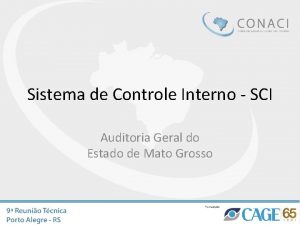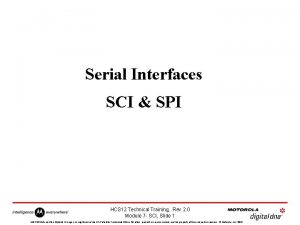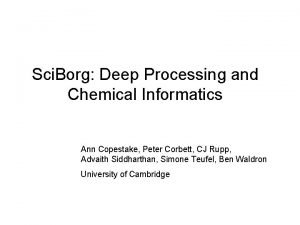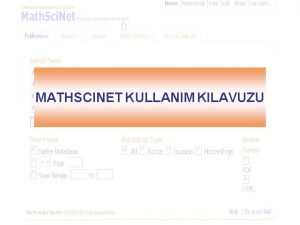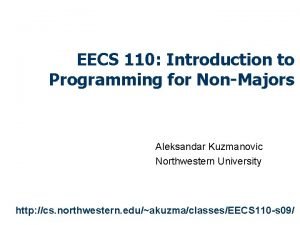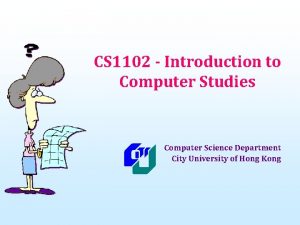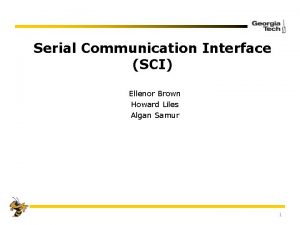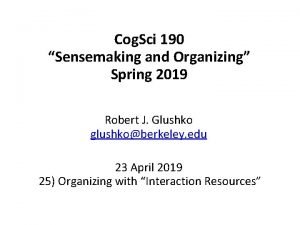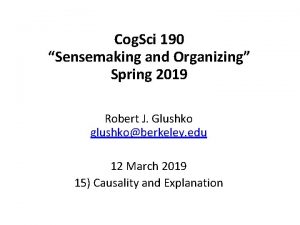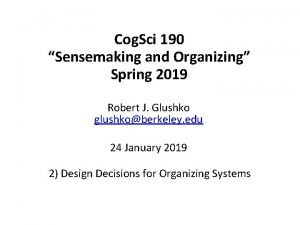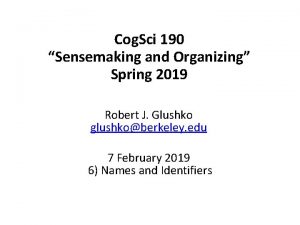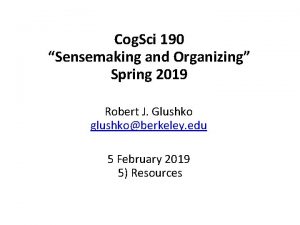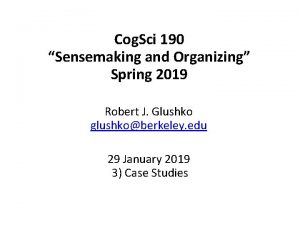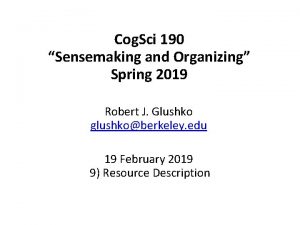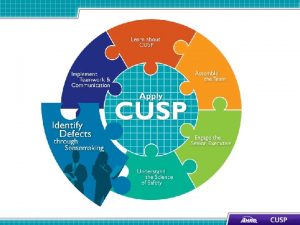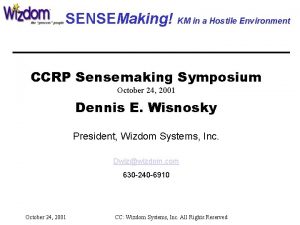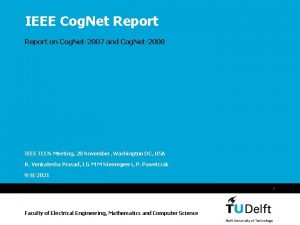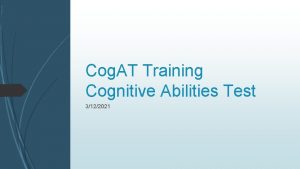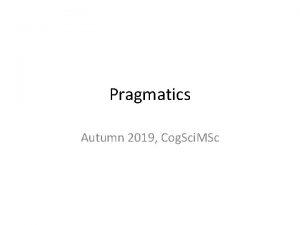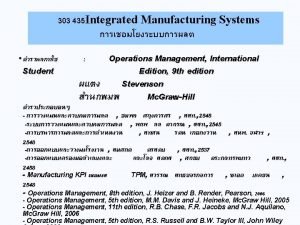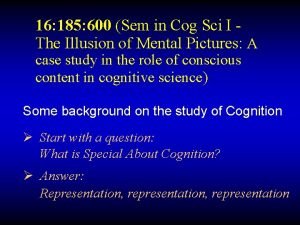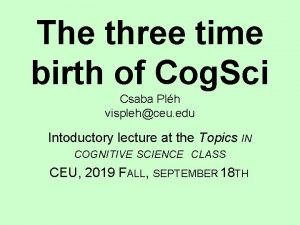Cog Sci 190 Sensemaking and Organizing Spring 2019

























![Organizing Principles [2] l l l What organizing principles are “generic” in the sense Organizing Principles [2] l l l What organizing principles are “generic” in the sense](https://slidetodoc.com/presentation_image_h2/4421fdf34838873a184ecb34ffe51256/image-26.jpg)
![Organizing Principles [2] • For physical resources the properties are often: • Perceptual – Organizing Principles [2] • For physical resources the properties are often: • Perceptual –](https://slidetodoc.com/presentation_image_h2/4421fdf34838873a184ecb34ffe51256/image-27.jpg)
![Organizing Principles [3] l l l Other typical arrangements are based on ownership, origin, Organizing Principles [3] l l l Other typical arrangements are based on ownership, origin,](https://slidetodoc.com/presentation_image_h2/4421fdf34838873a184ecb34ffe51256/image-28.jpg)





















- Slides: 49

Cog. Sci 190 “Sensemaking and Organizing” Spring 2019 Robert J. Glushko glushko@berkeley. edu 18 April 2019 24) REVIEW: Organizing, Categorization, and Classification

S & O Endgame… • 4/18: 2 nd Course Review • 4/23: “Interaction Traces” ; “Diary for a Day” Assignment; CASE STUDIES • 4/25: “Computational Description” • 4/30: “Computational Classification” ; Discuss “Diary for a Day” Assignment • 5/2: PRACTICE EXAM • 5/3: Last Day for “Free Read” of Case Study Report • 5/7: FINAL EXAM anytime until 5/14 • 5/9? : Case Study Presentations; Class Party • 5/12: Case Study Reports Due

Buy This Book! (only $5. 75 on Amazon) If you don’t think it was worth it, I will buy it back from you

The Document Type Spectrum • Different domains or types of documents can be distinguished according to the extent to which their content is semantically prescribed, by the amount of internal structure, and by the correlations of their presentation and for matting to their content and structure

The Document Engineering Approach


Course Review / Practice Exam • The remainder of the slides serve as a course review on organizing principles, categorization, and classification • SLIDES IN RED are questions for you to answer (either in your group or by yourself if you’re not in class today) • Questions like these will be on your practice exam (May 2) and on your take-home final exam • The slides that follow each RED slide review the relevant concepts and guidance for answering the question, so don’t look at them before you’ve tried to answer it

The “Milk” Category • Define “milk” • Do “soy milk” or “almond milk” or other plantbased drinks (that vegans or lactose-intolerant people drink) fit into the milk category? – What is the best argument for including these drinks in the milk category? – What is the best argument for not including these drinks in the milk category?

Cultural Categories • We use tens of thousands of categories that are embodied in our culture and language • They develop slowly and typically change slowly • Many have a perceptual or sensorimotor origin based on natural boundaries or discontinuities in perception and experience • Learned implicitly through development via parent child interactions, language, and experience • Informal and contextual acquisition makes cultural categories flexible, creative, generative 9

Institutional Categories for Chicken: UN Standard Products and Services Codes https: //www. unspsc. org/ Who would need something like this? 10

Faceted Classification • You are organizing these household “tools” : Blender, Screwdriver, Tape measure, Frying pan, Electric Drill, Rake, Sponge mop, Vacuum cleaner, Shovel, Bucket 1) Create a faceted classification system for household tools that uses between 3 and 5 facets, along with the values that each facet can have 2) What facets did you consider but choose not to use? Why are they not as good as the ones you chose?

Choosing Facets • ORTHOGONALITY - facets are independent dimensions • SEMANTIC BALANCE - top level facets are the most important semantic dimensions of the domain; values within facets are at equal semantic level • COVERAGE - all current instances can be classified • SCALABILITY - future instances can be classified • OBJECTIVITY - instances can be objectively classified; might also be called CONCRETENESS • NOT IDIOSYNCRATIC - facet semantics should be "mainstream" or "normative" and not rely on clever, fanciful or metaphoric interpretation 12

Hierarchical Classification • You are organizing these household “tools” : Blender, Screwdriver, Tape measure, Frying pan, Electric Drill, Rake, Sponge mop, Vacuum cleaner, Shovel, Bucket 1) Create a hierarchical classification system for household tools (TOOLS is the root) with at least one level of hyponyms between the root and the leaf nodes where the specific tools are organized 2) What hyponyms did you consider but choose not to use? Why are they not as good as the ones you chose? 3) Which classification is better, the faceted one or the hierarchical one? 4) Would your classifications be different if you had done the hierarchical one first?


Hierarchy and Uniqueness Principles • Hierarchy: Each category is successively divided into smaller subdivisions according to a feature or property • Uniqueness: Every type of resource is classified in only one subdivision • These two principles are very common, might feel like “natural” principles What assumptions about the domain are implied by this kind of classification? 15

Categorization and Bias It has been said many times this semester that “Every system of categories is biased. ” • What are the sources of this bias? • Is this typical bias a good thing or bad thing? • How is bias different in (a) categories created by an individual for personal purposes (b) cultural categories (c) institutional categories? • How can you reduce or eliminate the bias in a system of cultural categories?

Every Classification is "Biased" • Every classification is arbitrary because the criteria used to establish the categories reflect a point of view or perspective on the domain that intentionally excludes all other perspectives • Every classification system implicitly or explicitly contrasts {"good", "standard“} and {"bad", "nonstandard“} ways of understanding things • Natural vs. man made disaster? • Dietary supplement vs. beverage? • Employee vs. contractor, full vs. part time? 17

FLASHBACK Individual Categories • Created to satisfy ad hoc requirements that emerge from an individual’s unique experiences, preferences, and resource collections • Created intentionally in response to specific organizing requirements, often short term ones • Can have an imaginative or metaphorical basis that distorts or misinterpret cultural categories • Collection hobbies often embody peculiar individual categories 18

Why => Bias in Organizing Systems l l l Personal and cultural categories and organizing systems are highly biased Creating institutional categories using more systematic processes does not prevent them from being biased Indeed, the goal of institutional categories is often to impose or incentivize biases in interpretation or behavior 19

Organizing Principles • Intentional arrangements of resources arrangements follow one or more ORGANIZING PRINCIPLES. These principles use properties or descriptions that are associated with the resources. • Why is it desirable to think of these principles in an implementation neutral way? • What comes first, the descriptions or the organizing principles? • What is the relationship between resource descriptions, organizing principles, and interactions in an organizing system? 20

FLASHBACK The Three-Tier Architecture Organizing Principles are logically separated from Implementation and Presentation Tiers

Expected Lifetime Usually correlated with number of users and resources; small collections with single users are often ad hoc and don’t outlive the specific tasks for which they were created l Think architecturally to enable more robustness and flexibility with respect to changes in technology or business contexts l 22

Classification and Interactions • Effective user interfaces to physical or digital organizing systems present and reinforce the logical classifications they embody • If the resources belong to logical groups or categories, does the arrangement of the controls reflect them? 23

Choice Architecture in TDOspeak Choice Architecture says: TDO says: • There is no neutral architecture • We can vary the order of choice alternatives • We can change the number of categories • We can change the labels of alternatives or categories • People prefer choices that are easier to describe • TRADEOFFS • All systems of categories are biased • We can use different organizing principles • We can vary the abstraction and granularity of categories • Naming and resource description is difficult, contentious, and makes a difference • TRADEOFFS

Let Me Say it Another Way • Resource description and organizing are intrinsically connected • You can’t organize what you haven’t described implicitly or explicitly. . because the principles embodied in any organizing system reflect decisions about what resource descriptions to use
![Organizing Principles 2 l l l What organizing principles are generic in the sense Organizing Principles [2] l l l What organizing principles are “generic” in the sense](https://slidetodoc.com/presentation_image_h2/4421fdf34838873a184ecb34ffe51256/image-26.jpg)
Organizing Principles [2] l l l What organizing principles are “generic” in the sense that they can be used for almost any type of resource? Why is it sometimes necessary to use organizing principles that only work in very limited resource domains? Does it matter in which order the organizing principles are applied to arrange a collection of resources? 26
![Organizing Principles 2 For physical resources the properties are often Perceptual Organizing Principles [2] • For physical resources the properties are often: • Perceptual –](https://slidetodoc.com/presentation_image_h2/4421fdf34838873a184ecb34ffe51256/image-27.jpg)
Organizing Principles [2] • For physical resources the properties are often: • Perceptual – what does it look like? • Material – what is it made of? • Task oriented – how is it used? • For information resources the properties are often semantic ones – what is it about? 27
![Organizing Principles 3 l l l Other typical arrangements are based on ownership origin Organizing Principles [3] l l l Other typical arrangements are based on ownership, origin,](https://slidetodoc.com/presentation_image_h2/4421fdf34838873a184ecb34ffe51256/image-28.jpg)
Organizing Principles [3] l l l Other typical arrangements are based on ownership, origin, taxonomic, or “taskonomic” or behavioral properties (usage frequency, correlated usage) Any resource with a orderable name or identifier can have alphabetic or numeric ordering Any resource with an associated date (creation, acquisition) can have chronological ordering 28

Description is Challenging! People use different words for the same things, and the same words for different things (TDO 4. 4) l. Describing and organizing always (explicitly or implicitly) takes place in some context l The context shapes which resource properties are important and the organizing principles that use those properties 29 l

Multiple Properties in Different Order Organizing the Shirts in a Department Store 30

Taxonomy and Taskonomy • Define each of these organizing approaches • Think of some examples where they can coexist in an organizing system • How do these approaches relate to the concepts of distributed cognition?

The Semantics of "Inclusion" • One class or type of resources logically contains another; predicate is usually “is-a” or "is-a-type-of" • A set of interconnected class inclusion relationships defines a HIERARCHY or TAXONOMY • An inclusion relationship between an instance and a class assigning an instance to a class is CLASSIFICATION 32

Taskonomy • In contrast to "taxonomy" - an approach to organization based on similarity of content or characteristics - a "taskonomy" organizes on the basis of purpose or "activity structure“ • A COOK’S TASKONOMY (Figure 8. 1 in TDO) 33

Using Space to Simplify Choice • A production line serially decomposes a complex task by dividing the space in which it is performed into functional stations where sub-tasks are performed • Each spatial region creates a task context in which only certain skills, tools, and rules are appropriate • Once a context has been selected, the local affordance make clear what can and must be done The New Mc. Donalds Layout

Natural and Basic Categories • Why do we consider some types of categories to be more natural than others? • Why do we consider some levels of abstraction in categories to be more basic than others? • Are natural and basic categories the same in all cultures? Why or why not?

FLASHBACK “Carving Nature at its Joints” l l l Over 2000 years ago Plato argues that species are distinguished by "carving nature at its joints" - where the natural differences between things are the largest or most salient or where there are few connections I. e. , there are “natural kinds” – categories are discovered, not invented "Joints" and the boundaries they create between things exist to some extent with physical resources and are manifested in their surface or perceptible properties 36

Three-Level Category Hierarchy

Basic-Level Categories: Why “The world is structured because real-world attributes do not occur independently of each other” “Combinations of attributes of real objects do not occur uniformly. Some pairs, triples, or n-tuples are quite probable, appearing in combination sometimes with one, sometimes another attribute; others are rare; others logically cannot or empirically do not occur. ” Basic objects (e. g. , bird, chair) are at the level at which there attributes common to all or most members of the category

FLASHBACK Shared Visible Features Carve These Animals into Two Categories

Category Structure • What principles determine membership in a category defined by enumeration? • What kinds of problems can arise in the implementation and use of enumerated categories? • What kinds of categories are defined using “necessary and sufficient” properties? Why are these categories preferred by designers of information systems?

Defining Categories by Enumeration Simplest way to define a category is by enumerating (listing) its members l This principle is also called EXTENSIONAL definition; the members of the set are called the EXTENSION l This principle is easy to understand implement; the meaning of a category or concept is NOT a property test; it is simply the specific set of resources associated with it l So learning an enumerative category just means “memorizing its members” l 41

The Limits of Enumerative Definition l At some point an enumerative category might contain so many members that it must be subdivided or be given a definition based on principles other than enumeration What happened to the “planet” category when large objects were discovered orbiting around stars other than the Sun? 42

Specifying Enumerations You should be excruciatingly careful when you define a category by enumeration l The legal principle of “implied exclusion” says that if you “expressly name” or “designate” some list anything not named is excluded l Legal disputes often reflect different interpretations of category membership and whether a list of category members is exhaustive (“the following”) or merely illustrative (“including” or “such as”) Why is an “Other” category usually a bad idea? l 43

Classical Categories l l “Classical” categories can have large numbers of category members, but they have clear boundaries defined by a small number of ESSENTIAL or necessary and sufficient properties Necessary means that every instance must have the property to be in the category Sufficient means that any instance that has the necessary properties is in the category Example: A Prime Number is an integer divisible only by itself and 1 l Every prime number has these properties l If a number has these properties, it is prime 44

Classical Categories l l “Classical” categories can have large numbers of category members, but they have clear boundaries defined by a small number of ESSENTIAL or necessary and sufficient properties Necessary means that every instance must have the property to be in the category Sufficient means that any instance that has the necessary properties is in the category Example: A Prime Number is an integer divisible only by itself and 1 l Every prime number has these properties l If a number has these properties, it is prime 45

Naming is Hard! • What kinds of problems can arise with “naturally-occurring” names? • How can these problems be prevented, eliminated, or made less serious? • If you are creating an organizing system in some domain and discover a controlled vocabulary in that domain, what should you do?

Issues with Names and Naming – 1 A specific resource or type or resource can often have multiple names; these are SYNONYMS or ALIASES l Different things can sometimes have the same names -- these are HOMOGRAPHS or POLYSEMES l l Which is the more important problem? 47

Issues with Names and Naming – 2 False cognates (GIFT, PAIN) l A name can have undesirable associations l A name can have assume impermanent attributes or associations or be “faddish” (baby names over time) l Alphabetic ordering bias l Autogenerated names don’t convey any meaning (SCAN 0098. JPG) l Problems caused by careless programmers l 48

Schemas/Domain-Specific Languages • In addition to standardizing the content of resource descriptions a CV might also standardize the features/properties/categories to which the standardized vocabulary is applied • This work represents a significant investment in defining a domain, identifying its key semantic components, and specifying the constraints and rules governing the combination and reuse of those components
 Cogsci c131
Cogsci c131 Karl weick sensemaking model
Karl weick sensemaking model Master data management mdm vs. sensemaking
Master data management mdm vs. sensemaking Cast of spring, summer, fall, winter... and spring
Cast of spring, summer, fall, winter... and spring Winter is white spring is green
Winter is white spring is green 6 determinants of gait
6 determinants of gait Coglab.wadsworth
Coglab.wadsworth Honda cog commercial
Honda cog commercial Gp cog
Gp cog Spasticity vs rigidity
Spasticity vs rigidity This session is being recorded
This session is being recorded Cog at
Cog at Hku cog
Hku cog Hku cog
Hku cog Bos cog log
Bos cog log Mini cog test
Mini cog test Cog 2018 2022
Cog 2018 2022 An elephant pushes with 2000 n on a load of trees
An elephant pushes with 2000 n on a load of trees Me 190 sjsu
Me 190 sjsu Cse 190
Cse 190 Cnm 190
Cnm 190 10 por cento de 190 755 799
10 por cento de 190 755 799 Ar 190-45
Ar 190-45 190 / 9
190 / 9 Lion poids 190 kg
Lion poids 190 kg Betreiberverantwortung gefma
Betreiberverantwortung gefma Cse 190
Cse 190 Svi rimski brojevi
Svi rimski brojevi Adva 190
Adva 190 S = bilangan asli
S = bilangan asli Boxford 190 vmc
Boxford 190 vmc Norse mythology creation
Norse mythology creation 190 vauxhall bridge road mental health
190 vauxhall bridge road mental health 190 words
190 words Cogsci 190
Cogsci 190 Journal of nanoscience and nanotechnology sci
Journal of nanoscience and nanotechnology sci Umass poli sci
Umass poli sci Sci technology work from home
Sci technology work from home Sci auditoria
Sci auditoria Spi vs sci
Spi vs sci Scigateway
Scigateway Sci-borg
Sci-borg Recursion ap computer science
Recursion ap computer science Math sci
Math sci Cs110 northwestern
Cs110 northwestern Comp sci 1102
Comp sci 1102 What is science fiction?
What is science fiction? Friends
Friends Sci communication
Sci communication Znaky sci fi
Znaky sci fi
